Zero-symmetric graph
The truncated cuboctahedron, a zero-symmetric polyhedron
In the
connected graph in which each vertex has exactly three incident edges and, for each two vertices, there is a unique symmetry taking one vertex to the other. Such a graph is a vertex-transitive graph but cannot be an edge-transitive graph: the number of symmetries equals the number of vertices, too few to take every edge to every other edge.[1]

The name for this class of graphs was coined by
R. M. Foster in a 1966 letter to H. S. M. Coxeter.[2] In the context of group theory, zero-symmetric graphs are also called graphical regular representations of their symmetry groups.[3]
Examples
The smallest zero-symmetric graph is a nonplanar graph with 18 vertices.[4] Its LCF notation is [5,−5]9.
Among
truncated icosidodecahedral graphs are also zero-symmetric.[5]
These examples are all bipartite graphs. However, there exist larger examples of zero-symmetric graphs that are not bipartite.[6]
These examples also have three different symmetry classes (orbits) of edges. However, there exist zero-symmetric graphs with only two orbits of edges. The smallest such graph has 20 vertices, with LCF notation [6,6,-6,-6]5.[7]
Properties
Every finite zero-symmetric graph is a
combinatorial enumeration tasks concerning zero-symmetric graphs. There are 97687 zero-symmetric graphs on up to 1280 vertices. These graphs form 89% of the cubic Cayley graphs and 88% of all connected vertex-transitive cubic graphs on the same number of vertices.[8]
Unsolved problem in mathematics:
Does every finite zero-symmetric graph contain a
Hamiltonian cycle
?
All known finite connected zero-symmetric graphs contain a
Hamiltonian cycle, but it is unknown whether every finite connected zero-symmetric graph is necessarily Hamiltonian.[9] This is a special case of the Lovász conjecture
that (with five known exceptions, none of which is zero-symmetric) every finite connected vertex-transitive graph and every finite Cayley graph is Hamiltonian.
See also
- Semi-symmetric graph, graphs that have symmetries between every two edges but not between every two vertices (reversing the roles of edges and vertices in the definition of zero-symmetric graphs)
References
- MR 0658666
- ^ Coxeter, Frucht & Powers (1981), p. ix.
- ISBN 9780521529037.
- ^ Coxeter, Frucht & Powers (1981), Figure 1.1, p. 5.
- ^ Coxeter, Frucht & Powers (1981), pp. 75 and 80.
- ^ Coxeter, Frucht & Powers (1981), p. 55.
- MR 3646702
- MR 2996891.
- ^ Coxeter, Frucht & Powers (1981), p. 10.


